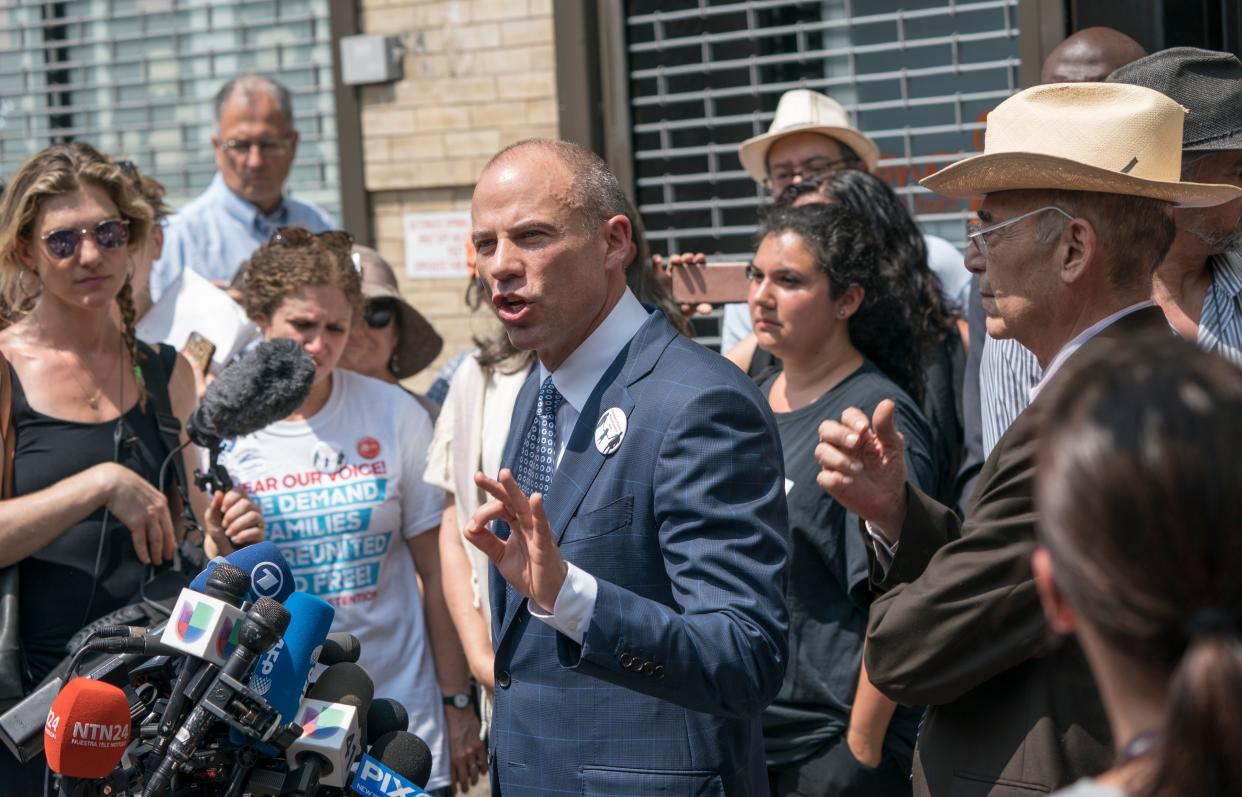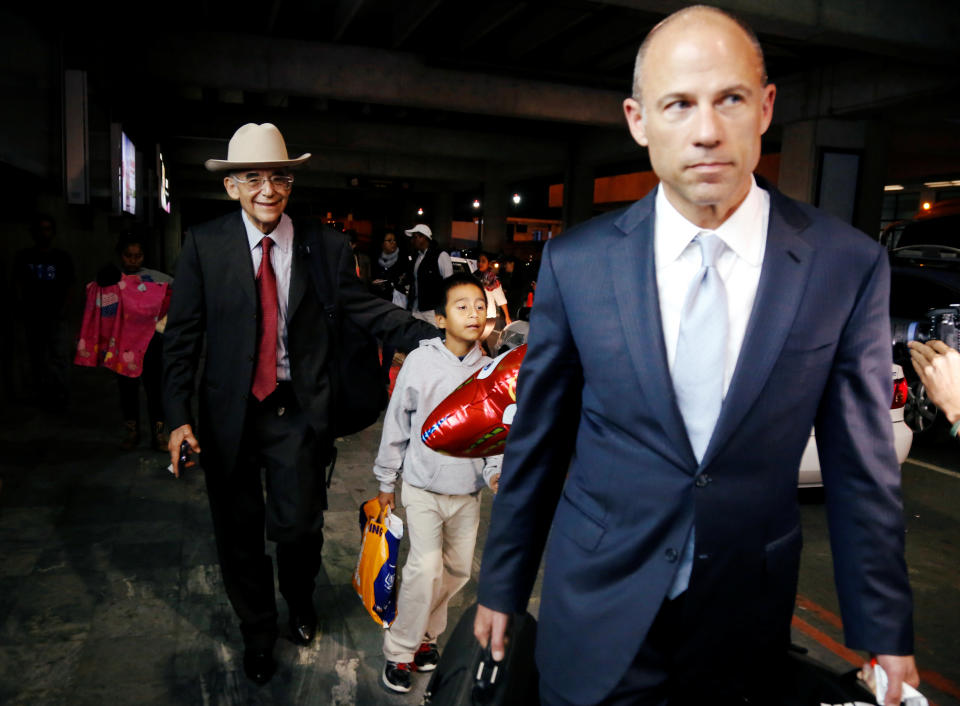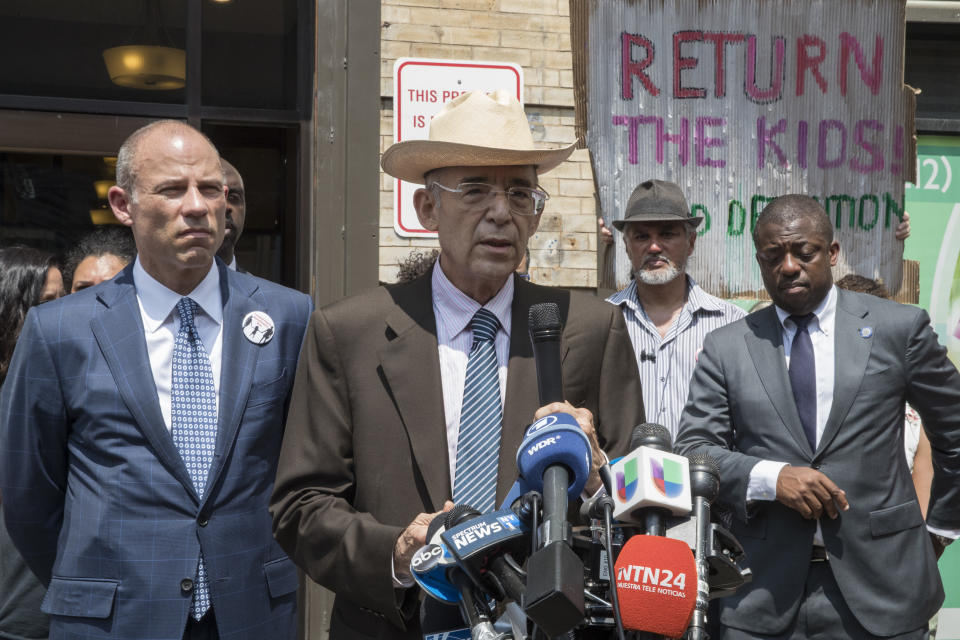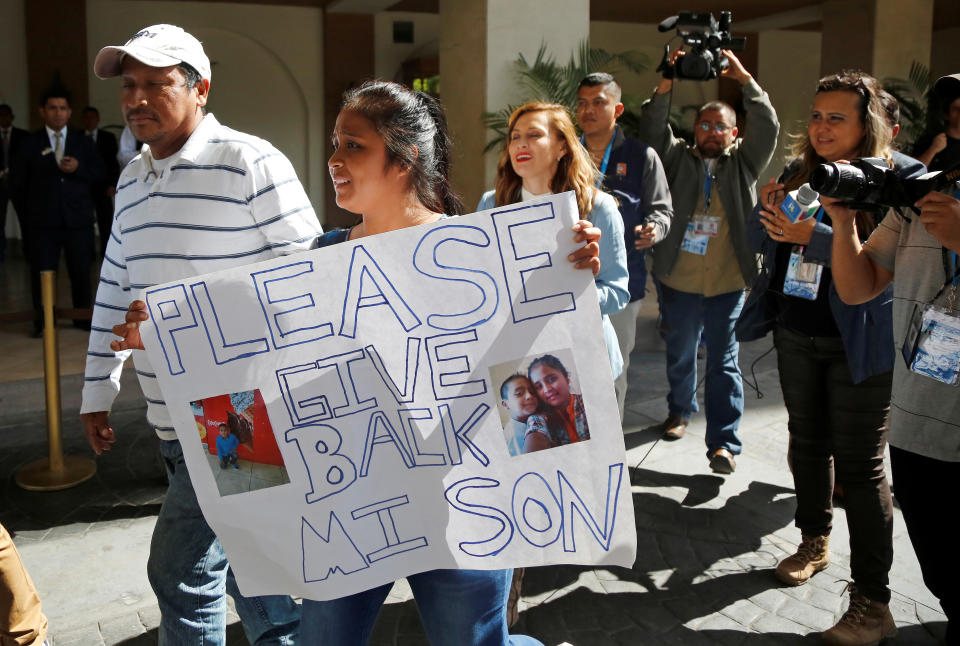Harnessing his star power to reunite families, Michael Avenatti responds to questions about his tactics

When Michael Avenatti first announced in June that he would take on the issue of family separation at the U.S.-Mexico border, many advocates for immigrants were thrilled.
Avenatti, who skyrocketed to national prominence earlier this year as Stormy Daniels’s media-savvy attorney, had proved himself to be a worthy liberal adversary for President Trump, driving news cycles with his regular cable news appearances and 700,000-plus Twitter following. Who better to draw attention to this much less tabloid-ready issue?
“I was initially very happy to see that he was lending his name and notoriety and public relations savvy to an important issue of public concern,” said R. Andrew Free, a Nashville-based immigration attorney whose firm specializes in deportation defense and other aspects of immigration law.
Anastasia Tonello, president of the American Immigration Lawyers Association, or AILA, thanked Avenatti on Twitter for his interest in the issue, and invited him to join the 15,000-member organization “in our fight for fair and just immigration laws and policies.”
.@MichaelAvenatti, thank you for working on family separation cases and raising the profile of this issue. As the President of @AILANational, I enthusiastically invite you to join our association of 15,000 lawyers in our fight for fair and just immigration laws and policies.
— Anastasia Tonello (@anastasianylon) June 21, 2018
But in the time since, Avenatti’s characteristically brash approach to this particularly complicated area of immigration law has raised concern among immigration attorneys, who worry that he may be out of his depth at best — and, at worst, placing his own interests above those of his vulnerable clients.
Avenatti, in an interview with Yahoo News, dismissed those concerns as “ridiculous,” and slammed the attorneys who’ve raised them as “hacks” who “know nothing about my cases. Nothing. Zero.”
But Matthew Kolken, a Buffalo-based immigration attorney and elected member of AILA National’s board of governors, told Yahoo News that “those of us who have been in the trenches are uniform in our concern about the way he is handling cases.” Kolken said he’s spoken to about a dozen other attorneys with expertise in deportation defense over the last week or so, and “there’s been pretty much a meeting of the minds.”
Though a number of Avenatti’s tactics have raised red flags over the past two months or so since he joined the family separation fight, the primary point of contention right now is whether the celebrity lawyer-turned-prospective presidential candidate is equipped to provide the best legal guidance to the nearly 80 immigrant parents and 100 children he told Yahoo News he’s now representing pro bono — a caseload one experienced attorney described as “insane.”
Amid ongoing efforts by advocates to ensure the rights of all separated children to pursue their own claims of asylum or other legal relief in the United States, Avenatti drew much scrutiny last week with the highly-publicized return of an 8-year-old client to his deported mom in Guatemala, the country his mother had previously said they fled due to fears of growing violence. That case, which Avenatti told Yahoo News is one of “multiple” in which he’s returned separated kids to parents who were deported without them to their home countries, has specifically raised questions about whether, in an effort to quickly reunite separated families, Avenatti may be foregoing some of his clients’ legal rights to relief in the U.S. and, inadvertently, putting them in harm’s way.

“For experts in the field, it feels like we’re watching a Holiday Inn Express commercial,” Kolken said, referring to what he and others worry is Avenatti’s rapid-paced, one-size-fits-all approach to serving potentially vulnerable clients in a highly nuanced and incredibly complex area of immigration law.
“Obviously the reunification of the child is of paramount concern,” Kolken said, emphasizing that he does not know the specific details of Avenatti’s clients’ cases but has years of experience defending immigrant children from deportation to countries like Guatemala. “But reuniting parent and child in the place that they fled because of unspeakable violence isn’t necessarily the answer either.”
“They’re completely talking out of their ass, and I resent it,” Avenatti said, going on to accuse “some of these expert attorneys” of wanting to use immigrant children as political pawns “to further their own larger legislative and policy goals.”
Indeed, all of the attorneys who spoke to Yahoo News for this story made clear that they did not know the specifics of Avenatti’s clients cases and acknowledged that, under certain, albeit rare, circumstances, a voluntary departure — which comes with a 10-year ban on entering the U.S. — may actually be the best legal option. The bigger issue, they argue, is that Avenatti seems to not fully grasp the sensitive nature of the cases he’s taken on and, what’s more, appears to be using his platform to advocate for solutions that, they fear, are simply furthering the Trump administration’s agenda.
“Kudos to him for trying to help, but the reality is you’ve got to help in the way that is beneficial to the child and not the system,” said Charles Kuck, an Atlanta-based immigration attorney and former AILA president. “If all you want to do is deport kids, you’re basically doing Jeff Sessions’ job.”
Attorneys began to question Avenatti’s approach to the family separation issue not long after he announced, via Twitter, that he was “entering this fight,” asking anyone who “knows of a parent that has had their child taken from them at the border and not returned” to contact him. After rebuffing initial offers for help and guidance from many in the immigration law community, Avenatti teamed up with Ricardo de Anda, an attorney based in Laredo, Texas, who had reached out to him via Twitter. After a number of visits with both detained parents and children at facilities in Arizona, California and Texas, Avenatti took to Twitter with a proposal to reunite all separated immigrant families inside what he called a “single staging area.”
I rarely ask for help but I’m asking now. We need to pressure the govt to reunite families NOW by using a single staging area approach. This can be solved but they need to act immediately before time and distance permanently destroys families. Please trend #SingleStagingAreaNow
— Michael Avenatti (@MichaelAvenatti) June 22, 2018
The idea, which he further explained in interviews, was to essentially relocate all detained children who’d been separated from parents and vice versa to a single, large facility, like a stadium or arena, where parents could try to find their kids among the thousands of others, who would all be organized alphabetically. The proposal, which Avenatti said he was discussing “with various individuals of the government,” was almost unanimously rejected as unworkable by immigration attorneys and advocates who’d been fighting against family detention since well before Trump took office.
“That’s the sort of idea that accepts, as a given, a premise that we were trying to push back on… the idea that people need to be confined,” said Free, the Nashville immigration attorney. “I pushed back at him, he blocked me.”
Free is among a number of attorneys who’ve said they were blocked by Avenatti on Twitter after reaching out to offer advice or criticism.
“The immigration bar is very open to helping each other, it’s a very warm community in that sense,” said Stephen Robbins, an attorney who specializes in family-based immigration, asylum and other forms of deportation defense. It was “unsettling to see this guy come along who was immediately very hostile to people who really have best interest of people involved.”
Avenatti does not deny blocking those who question or criticize his methods on Twitter.
“I’m a private citizen, I can block anybody I want,” he told Yahoo News. “And look, you know why I didn’t reach out to a lot of them? ’Cause I don’t need their help, that’s why. If I need their help I’ll let them know.”
“One of the things that I’ve always respected about people who are able to engage in a diverse array of fights and are able to fight on multiple fronts and multiple areas of law, is they typically surround themselves with the smartest people around and don’t take that as like a threat or an insult,” said Free. “There were those people available to him at the time and, instead of looking to them, he proposed a giant detention camp at a time when really we had the momentum.”

Avenatti’s use of social media to draw attention to the plight of his clients has also worried attorneys, given that so many of the families separated at the border had fled violence in their home countries.
For example, on June 20, Avenatti tweeted a photo of an ICE form on which one of his detained clients had requested communication with her child, only for the responding deportation official to write that he did not have the information on the child’s whereabouts. Four days later, Avenatti tweeted the same photo again in an attempt to counter the Trump administration’s claim earlier that day that it knew the location of all immigrant children in government custody. Both posts received over 7,000 retweets and even more “likes,” with thousands responding in outrage, praising Avenatti’s good work and asking where to donate to the cause.
However, the tweets stood out to many immigration attorneys because the unredacted documents contained his client’s full name, nationality and alien registration number — a unique identification number assigned to all noncitizens upon entering the immigration system. Buried in the outpouring of support were a number of tweets from attorneys urging Avenatti to remove — or at least redact — the form, warning that publicizing such personal information could be dangerous for his client if she, like so many of the other parents separated from their children at the border, was seeking asylum.
Nearly two months later, both tweets containing the unredacted form are still live in Avenatti’s feed.
“We haven’t released a single piece of information that we were not permitted to release by authorization of the client,” Avenatti responded.
Avenatti is an experienced litigator and self-described defender of “Davids,” taking on corporate “Goliaths” in high-stakes legal battles that, in a number of noteworthy cases, have yielded multimillion dollar awards. But immigration court is not part of the regular judicial system. Not only is it governed by a completely different set of rules but, under Attorney General Jeff Sessions, those rules and policy procedure are constantly changing in ways that disadvantage those fleeing violence in Central America — who constitute a majority of those affected by the family separation policy.
“I think it would be very difficult, or at least frustrating, for a federal litigator to practice in immigration court,” said AILA’s Tonello, noting that “even immigration lawyers who have 10, 15 years’ experience are finding this area of immigration law challenging.”
Within immigration law, she explained, attorneys typically specialize in certain areas like business and employment issues, which almost never require them to enter an immigration court. Deportation defense is considered among the most complicated areas of immigration law. Of AILA’s 15,000-plus members, Tonello said, 6,537 selected “deportation” as an area of expertise on their membership applications or profile. Within that group, she said just 3,830 also identified litigation as a specialty, while 5,995 said they specialize in asylum.
To meet the growing need of immigrants facing deportation, AILA offers training to attorneys looking to get involved in removal defense.
As far as Tonello knows, Avenatti hasn’t taken her up on the invitation to join AILA.
“I hope that he has lawyers who are experienced and know what they’re doing, because you can’t count on your status — as in any court case — to ensure an outcome,” she said. “Just because he’s got a big name and some celebrity doesn’t mean that his clients are going to succeed.”
According to the state bar of Texas, the practice of Avenatti’s co-counsel, Ricardo de Anda, includes immigration as well as commercial, construction and business litigation.

Shortly after Avenatti’s first very public visit to the border, a judge in San Diego ordered all parents and children separated under the administration’s “zero tolerance” policy to be reunited within a month, in response to class action lawsuit brought by the ACLU. In the process of reuniting the families it had torn apart, the government revealed that hundreds of parents had already been deported without their children — prompting additional class action lawsuits.
One suit, now before U.S. District Court Judge Dana Sabraw, seeks to prevent the government from using reunification as an incentive for parents to accept deportation. The lawsuit argues that the government has been forcing parents to choose between being deported with their children — keeping the family together but waiving the children’s right to pursue an asylum on their own — or accepting deportation and leaving their children behind in the U.S.
Last week, Sabraw agreed that reunited children have a right to pursue their own asylum claims, and he issued a temporary order blocking the government from deporting any families who’d been separated as a result of the zero tolerance policy. The lawsuit also asks the judge to consider whether parents who were already deported after waiving their right to reunification, including many who’ve said they were coerced into signing such waivers, should be returned to the U.S. and given a second chance to pursue asylum alongside their child.
For those paying close attention to the latest developments in this case, it was quite jarring to then see Avenatti — who’d since begun exploring a run for the White House — tweeting photos of one of his clients, a young boy, first in immigration court and then at the United Airlines ticket counter, his famous attorney’s hands on his shoulders, proudly announcing that he was sending the child “home to Guatemala to be reunited with his mother.”
“I don’t know the facts of [this child’s] specific case,” said AILA’s Kolken, reiterating that “accepting voluntary departure may have been the proper call legally, especially when the parent has already been removed.” However, Kolken continued, “I know if I were representing an asylum seeker, the publicity stunt of taking the child to the airport and having the press follow you is not the way to do it. Because guess who’s going to be waiting for that child when he gets off of the plane? The same people they were fleeing from in the first place.”
81 days after being forcibly separated from his mother due to the cruel and unusual president, Antony is going home to Guatemala to be reunited with his mother. Finally. #Basta pic.twitter.com/tduRg3jT9T
— Michael Avenatti (@MichaelAvenatti) August 15, 2018
“When you engage in a publicity stunt as a precursor to a presidential campaign, it gives those of us who have been doing this as a living for decades pause,” said Kolken, suggesting that Avenatti was “using hundreds of thousands of Twitter followers and press’s love of his attacks on the Trump administration to further his political aspirations, not to further the interests of the children. Those are the only interests that matter.”
Kuck, the Atlanta immigration attorney, said that while he does not know the specific details of this client’s case, in general he would not advise accepting a voluntary departure order for a child before first attempting to pursue an asylum claim or some other form of relief. If the child is forced to flee their home country again and enters the U.S., a prior removal order on their record could land them in either expedited removal proceedings or federal prison.
“There’s lots of immigration law reasons not to do what he’s doing in the way that he’s doing it,” said Kuck.
Yahoo News spoke with Avenatti about his practice and the criticisms he’s faced. The attorney reacted at the outset with suspicion and defensiveness.
“Why don’t you tell me what your angle is and then I’ll tell you whether I want to continue to participate,” Avenatti demanded minutes into a phone interview with Yahoo News that, up to that point, had only included basic questions such as how many immigrant families he’s currently representing and how many of his clients have been deported without their children.
Asked then to address concerns expressed by immigration attorneys about his handling of these cases, Avenatti said, “I think it is an absolute outrage, outrage, for any attorney to make statements without any basis whatsoever when they know nothing of what they’re talking about relating to my client and what they’ve asked us to do,” he continued, referring to the questions his tactics have raised as “spurious, ridiculous accusations by these hack lawyers that opine about things that they know nothing about.”

In the case of the child whose highly publicized return to Guatemala had riled so many in the immigration law world, Avenatti said, “His mother contacted our office after she was deported. She wanted her kid back.”
“They were not interested in him continuing to pursue an asylum claim. Period,” he continued. “You cannot pursue an asylum claim for somebody that doesn’t want an asylum claim pursued.”
Avenatti said the 8-year-old was just one of “multiple kids” he’s helped reunite with deported parents in their home countries.
“The attorney doesn’t decide what to do, the client ultimately decides what to do,” he said. “And if the client decides that they want to be reunited with their child, outside the United States and that is the most important thing to them, that is our job, and that’s what we do.”
Asked whether he’s been following the developments in class action lawsuits that could, potentially, affect his clients’ ability to remain and possibly even return to the United States, Avenatti said, “Of course we’re following those cases and I’ve had a number of communications with the ACLU. I’ve enjoyed a very good working relationship with the ACLU in connection with their case, OK?”
“Michael is among many attorneys who have reached out wanting to help these families,” Lee Gelernt, deputy director of the ACLU’s Immigrants’ Rights Project and lead attorney behind the initial lawsuit that spurred the court-ordered reunifications, said in a statement to Yahoo News.
“He mentioned he was interested but didn’t want to interfere with the ongoing litigation.”
Although Avenatti dismisses his critics in the immigration bar as “jealous and petty and absurd,” every one of them who spoke to Yahoo News said they believed Avenatti’s heart was in the right place. They said they hoped he was consulting with experienced immigration attorneys to provide the best counsel possible to his clients.
“Of course I have a team of lawyers, yeah,” Avenatti said, adding that while he’s “partnered with immigration lawyers,” he himself has “been working on immigration cases in one form or another for over 12 years, so I’m not new to this fight.”
“Anybody that says I don’t have any experience in immigration cases,” he said, “doesn’t know what the hell they’re talking about.”
_____
Read more from Yahoo News:



